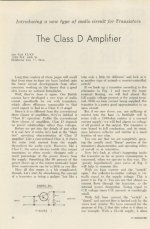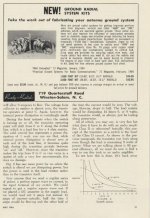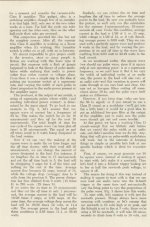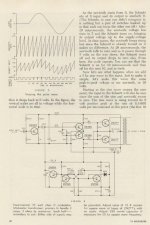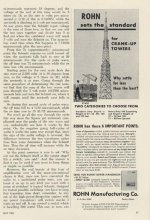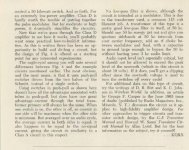a while back, there was a thread here trying to figure out what the earliest design and also usage of the term "class D" amplifier was. i can't remember the name of the thread, but i did find this article in 73 magazine from may 1964. i haven't read the whole article yet, but the amp described uses a 50khz switching frequency. another design which i saw from 1965 (1965 IEEE circuit cookbook) was much simpler (only 4 transistors and no transformers) and was called a "bang-bang" amplifier, so the term "class D", although it existed wasn't in common use, even by engineers. once i finish reading the article, i will probably post a pdf of the whole article. it looks as if this particular application was as an AM modulator in a transmitter. but driving a speaker is much simpler than driving a transmitter's PA stage, and the transformer may not even be neccessary.
Hans Camenzind, 555 timer inventor, dies
EN credits this guy with the invention Of NE555, PLL chips, class D and more. Presumably, he was aware of the technique from earlier work but perhaps his IC based designs made it more predictable. AD claim in their class D literature that it was invented, with the suitable chips, by Harris Technology in the 1990s (ahem!).
EN credits this guy with the invention Of NE555, PLL chips, class D and more. Presumably, he was aware of the technique from earlier work but perhaps his IC based designs made it more predictable. AD claim in their class D literature that it was invented, with the suitable chips, by Harris Technology in the 1990s (ahem!).
A.M. Modulation wasn't that difficult -- you could use a "modulation transformer" to drive the plate voltage, modulate the screen grid, or take a double-sideband signal and reinject the carrier. I think that most ham a.m. modulators used the first method and the signal was AB1 biased.
I don't see why it couldn't have been Class-D except that the birdies may have been too difficult to attenuate.
I still have a ton of 73's from the early 60's -- not sure of this one -- was it W1NSD?
I don't see why it couldn't have been Class-D except that the birdies may have been too difficult to attenuate.
I still have a ton of 73's from the early 60's -- not sure of this one -- was it W1NSD?
Modern Class D is different from 1970's Class D.
In the 1970's the various classes depended where on the load line the devices were biassed.
Class A has always been somewhere in the middle - this hasn't changed.
Class B has always been close to the end - this hasn't changed.
Class C was always hard at one end - this hasn't changed.
Class D used to only use the peaks of the output waveform, useful for SSB Radio Amplification, useless for audio.
So Class A would produce the full waveform. Class B would produce the full one-half plus a small portion of the other half (like a non-symmetrical Class A). Class C would produce only one half of the waveform and Class D would only produce the peaks of one half of the waveform.
Classes D upwards have now become synonymous with topologies rather than as they used to be.
So yes, the Class D amplifier may well have its routes back in the days of the Beatles, but the new digital amps are very different.
In the 1970's the various classes depended where on the load line the devices were biassed.
Class A has always been somewhere in the middle - this hasn't changed.
Class B has always been close to the end - this hasn't changed.
Class C was always hard at one end - this hasn't changed.
Class D used to only use the peaks of the output waveform, useful for SSB Radio Amplification, useless for audio.
So Class A would produce the full waveform. Class B would produce the full one-half plus a small portion of the other half (like a non-symmetrical Class A). Class C would produce only one half of the waveform and Class D would only produce the peaks of one half of the waveform.
Classes D upwards have now become synonymous with topologies rather than as they used to be.
So yes, the Class D amplifier may well have its routes back in the days of the Beatles, but the new digital amps are very different.
Last edited:
One of the first class D amp was the application example of Shockley diodes:
Transistor Museum Photo Gallery Shockley Diode Transistor 4 Layer
Transistor Museum Photo Gallery Shockley Diode Transistor 4 Layer
Member
Joined 2009
Paid Member
Why not call the new Digital D, Class DD instead of Class D.
You've never been a marketing guy then....
I went digging thru my files for early Class D information.
I found a 1978 paper "Digital Amplifier for Analog Power", by John A. Dutra.
That paper used the "Class D" term in describing amps with switched output stages driven by triangle generator derived PWM.
It referenced an earlier Electronic Letters paper, "Class BD Amplifier Circuit", in electronic Letters, December 1970, by J.D. Martin. That paper coined the terms AD and BD, depending upon how the input signal mapped to output switch operations.
I remembered the old Hans Camenzind paper that an earlier post alluded to, it's from September 1966 IEEE Transactions on Audio and Electroacoustics, Vol AU-14, No. 3, "Modulated Pulse Audio Power Amplifiers for Integrated Circuits". Camenzind points out that "Since the designations class A, B, and C refer to the biasing points of the active devices, and the amplifier under discussion uses a biasing point identical with class C, the term "class D" seems to be an unfortunate, if not confusing, choice"
The Camenzind paper refers to the technique being known for 35 years, and that was in 1966! It's also interesting in that it describes the work of one "A.G. Bose", now of various hifi fame.
I skimmed some of those patents...the switched nature of the output device seems to be common to them all. The thing that seems to change is the mapping of audio input to the switch(es) on-off control.
Perhaps if I get time, I can read the list of references to find the earliest reference to "Class D".
Akitika GT-101
I found a 1978 paper "Digital Amplifier for Analog Power", by John A. Dutra.
That paper used the "Class D" term in describing amps with switched output stages driven by triangle generator derived PWM.
It referenced an earlier Electronic Letters paper, "Class BD Amplifier Circuit", in electronic Letters, December 1970, by J.D. Martin. That paper coined the terms AD and BD, depending upon how the input signal mapped to output switch operations.
I remembered the old Hans Camenzind paper that an earlier post alluded to, it's from September 1966 IEEE Transactions on Audio and Electroacoustics, Vol AU-14, No. 3, "Modulated Pulse Audio Power Amplifiers for Integrated Circuits". Camenzind points out that "Since the designations class A, B, and C refer to the biasing points of the active devices, and the amplifier under discussion uses a biasing point identical with class C, the term "class D" seems to be an unfortunate, if not confusing, choice"
The Camenzind paper refers to the technique being known for 35 years, and that was in 1966! It's also interesting in that it describes the work of one "A.G. Bose", now of various hifi fame.
I skimmed some of those patents...the switched nature of the output device seems to be common to them all. The thing that seems to change is the mapping of audio input to the switch(es) on-off control.
Perhaps if I get time, I can read the list of references to find the earliest reference to "Class D".
Akitika GT-101
i haven't figured out how to export pages to a new pdf, so jpegs will have to do...
the article was by K5JKX. he mentions articles in Wireless World by D. R. Birt and K. C. Johnson, and a jun 63 Audio magazine article by George F. Cooper.
edit: maybe somebody else will have better luck, i have come up with zippo searching for the above authors or articles..
the article was by K5JKX. he mentions articles in Wireless World by D. R. Birt and K. C. Johnson, and a jun 63 Audio magazine article by George F. Cooper.
edit: maybe somebody else will have better luck, i have come up with zippo searching for the above authors or articles..
Attachments
Last edited:
was it W1NSD?
"never say die"
wasn't that his sigfile. so to speak?
I grew up reading 73, popular electronics, etc. good times.
No. SSB needs a linear amp, so usually Class B. I have never heard Class D used for anything other than the switch-mode amplifier used for audio and modulators.KatieandDad said:Class D used to only use the peaks of the output waveform, useful for SSB Radio Amplification, useless for audio.
Class D could be used for SSB as part of an EER system, but that uses a different principle so the Class D amp still operates in the normal way we understand today.
Class D should not be regarded as the next one after Class C. Instead, it should be seen as the first of the switch-mode amps: classes D, E and F. E and F are only used for narrow-band applications such as RF or fixed-frequency energy conversion.
Maybe D.R. Birt was this one? AES E-Library A Motion Transducer for Low-Frequency Loudspeakers......the article was by K5JKX. he mentions articles in Wireless World by D. R. Birt and K. C. Johnson, and a jun 63 Audio magazine article by George F. Cooper.
edit: maybe somebody else will have better luck, i have come up with zippo searching for the above authors or articles..
I'm thinkin ClassA is biased to work with the full waveform.
ClassB Uses only 1/2 the waveform but as we all know a complimentary style audio amp produces an output of the full waveform. It is effectively biased at zero.
ClassC however is only using some portion of the peak of the signal. Usefull in transmitters but useless for audio.
But, what do I know, I'm a dog
ClassB Uses only 1/2 the waveform but as we all know a complimentary style audio amp produces an output of the full waveform. It is effectively biased at zero.
ClassC however is only using some portion of the peak of the signal. Usefull in transmitters but useless for audio.
But, what do I know, I'm a dog

- Status
- This old topic is closed. If you want to reopen this topic, contact a moderator using the "Report Post" button.
- Home
- Amplifiers
- Solid State
- class d amp in 73 ham radio magazine 1964
